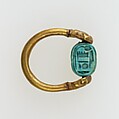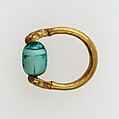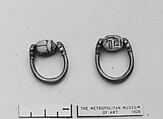Scarab finger ring with name of Amun-Re
New Kingdom
The Chantress of Amun, Henettawy, died in around 1000 B.C. at about the age of twenty. She was buried in a tomb located just outside the temple of the New Kingdom pharaoh Hatshepsut. This tomb originally may have been the resting place of one of Hatshepsut’s officials, Minmose, part of whose coffin was found in the debris inside. Henettawy seems to have been laid to rest hurriedly, as she had not even been embalmed but was simply wrapped in layers of linen bandages, and had no funerary furniture other than her nested coffins.
When the mummy was unwrapped (something the Museum no longer does today) two rings were found on Henettawy’s left hand. Their bezels are in the form of sacred scarab beetles, associated with the rising sun and regeneration. This scarab is inscribed on the underside with the name of the sun god Amun-Re, whose cult Henettawy served, placed beneath a large lotus bud and above a basket, the hieroglyph for lord. The other scarab (25.3.193) is inscribed on the underside with Hatshepsut’s throne name, Maatkare, flanked by two ostrich plumes that symbolize maat, the proper order of the cosmos.
The two scarabs date to early Dynasty 18 and are similar to examples found nearby in the foundation deposits of Hatshepsut’s temple (compare for example with 27.3.229, 27.3.230, 27.3.306). Thus Henettawy was wearing scarabs from the same period as the tomb that was apparently reused for her burial. It is unclear whether these scarabs came into her possession during her lifetime or were found in the older tomb, built five-hundred years before her death, during the preparations for her burial.
This image cannot be enlarged, viewed at full screen, or downloaded.
This artwork is meant to be viewed from right to left. Scroll left to view more.




